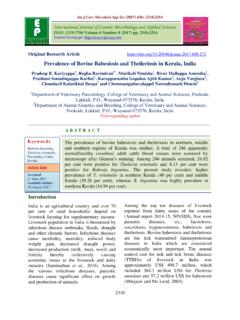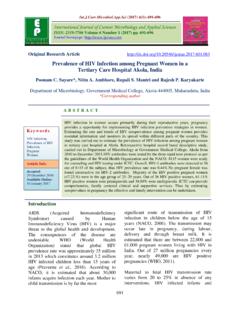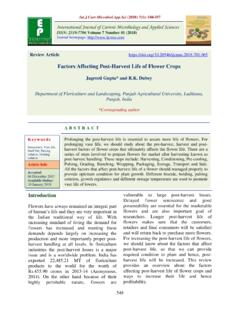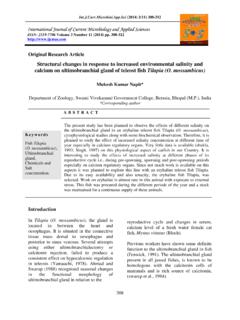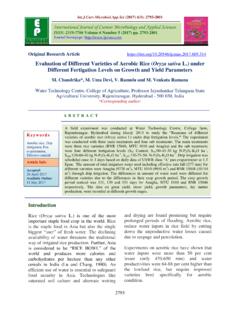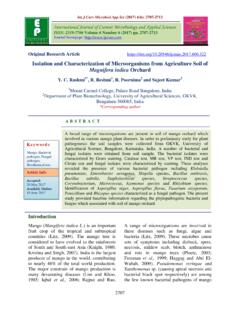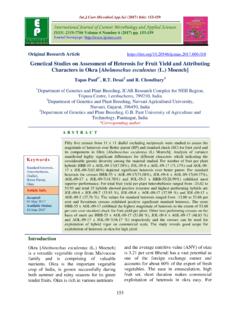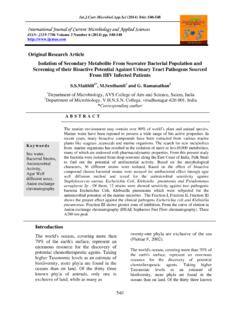Transcription of International Journal of Current Microbiology and …
1 (2018) 7(1): 967-975 967 Original Research Article Isolation and Characterization of Phosphate Solubilizing Bacteria from the Rhizosphere of Potato Plant Deepak Pandey and Chayanika Putatunda* School of Biotechnology and Biosciences, Lovely Professional University, Jalandhar - Delhi Road, Phagwara, Punjab-144411, India *Corresponding author A B S T R A C T Introduction Potato is a major crop grown in different parts of the world. According to an estimate the total world potato production was estimated at tonnes in FAO data shows that China is now the biggest potato producer, and almost a third of all potatoes is harvested in China and India (http://www.)
2 Farmers cultivate potatoes by using seed potatoes that have been cut in half with at least one eye on each piece. They plant them in rows about 2 to 3 feet apart and 2 to 4 inches deep. After about 90 to 140 days they will dig them up carefully and store in cool temperatures between 50o to 60o degrees F in a dark location (Ensminger et al., 1986). The crop belongs to the family Solanaceae and was domesticated by pre-Columbian civilizations in the Andean highlands of Peru and Bolivia (Pamela, 2010).It is well known that for biological growth and development of plants Phosphorus acts as one of the major essential macronutrients.
3 About 150 kg/ha phosphate chemical fertilizer in inorganic form is the best amount for potato cultivation (Singh et al., 2003). Absence of this element International Journal of Current Microbiology and Applied Sciences ISSN: 2319-7706 Volume 7 Number 01 (2018) Journal homepage: Phosphorus is important for early shoot and root development, providing energy for plant processes such as ion uptake and transport. Phosphorus is the most important nutrient element (after nitrogen) limiting agricultural production in most regions of the world. Phosphorous is the second major nutrient for the plants, however, it is the least soluble in soil.
4 The total phosphorous in the soil ranges from - per cent but only a small amount of it is available to the plants. In the present study, a total of ten different bacterial isolates were obtained from potato rhizosphere soil collected from different locations. Out of these, Enterobacter cancerogenus D-m-2, having potential to solubilize insoluble inorganic phosphate was characterized. The strains showed diverse levels of phosphate solubilization activity in liquid broth culture in presence of various carbon and nitrogen sources. Enterobacter cancerogenus D-m-2 showed maximum phosphate solubilizing with lactose as carbon source and ammonium oxalate as nitrogen source.
5 The final value of in vitro Phosphate solubilization by the isolate was g/ml. K e y w o r d s Phosphate solubilization, Bacteria, Rhizosphere, Enterobacter cancerogenus, Potato Accepted: 10 December 2017 Available Online: 10 January 2018 Article Info (2018) 7(1): 967-975 968 in the soil could limit the plant development (Prejambada et al., 2009; Victoria et al., 2009). The use of chemical fertilizers incurs extra burden on the farmers apart from causing environmental problems (Maheswar, 2012). A number of bacterial species, mostly those associated with the plant rhizosphere, are able to exert a beneficial effect upon plant growth.
6 This group of bacteria has been termed as plant growth promoting rhizobacteria (PGPR) and among them are strains from genera such as Pseudomonas, Serratia, Azospirillum, Burkholderia, Bacillus, Enterobacter, Rhizobium, Erwinia, Alcaligenes, Arthrobacter, Acinetobacter and Flavobacterium (Rodr guez et al., 1999).Many of these microorganisms act as phosphate solubilizing agent and convert the insoluble phosphorus into soluble form HPO42- and H2PO4- by production of acids, exchange reactions, acidification, chelation, and polymeric substance formation (Delvasto et al.)
7 , 2006).These microorganisms thus reduce the dependence on chemical fertilizers and hence are being regarded as an alternative to the conventional chemical fertilizers. Several workers have reported the isolation of various phosphate solubilizing bacteria from rhizospheres of a variety of plants. Islam et al., (2006) isolated and purified a total of 30 bacterial strains from the rhizoplane of rice by repeated streak culture on NBA medium. The phosphate solubilization index of the rice isolates varied from to The isolate Acinetobacter sp. BR-25 exhibited the highest phosphate solubilization index ( ) followed by BR-15 ( ) when calcium phosphate was used as P source.
8 Maheshwar et al., (2012) collected the soil sample from different rhizosphere soil of groundnut and reported the presence of phosphate solubilizing microorganisms. The isolated bacterial strains of Bacillus subtilis and Bacillus cereus, exhibited maximum phosphate solubilization and were found to be active in solubilization of tricalcium phosphate under in-vitro condition. In the present investigation potato rhizosphere soil samples were used to ascertain the presence of phosphate solubilzing bacteria and to check their phosphate solubilization activity under in vitro conditions.
9 Materials and Methods Isolation of Phosphate solubilizing Bacteria Rhizosphere soil samples from the potato plant was collected from Phagwara (Punjab), Karnal (Haryana), Dehri on sone (Bihar), Shahjahapur (Uttar Pradesh), and Harda (Madhya Pradesh). Each rhizosphere soil sample was serially diluted and then plated on Pikovskaya medium (Pikovskaya, 1948) plates and incubated at 370 C for 72 hrs. The composition of Pikovskaya s medium was as follows (g/L): Glucose- 10, Tricalcium Phosphate- 5, Ammonium sulphate- , sodium chloride- , Magnesium sulphate- , Potassium chloride- , yeast extract- , Manganous sulphate- , Ferrous sulphate- The bacterial isolates obtained were purified by streaking on fresh Pikovskaya s media and purified isolates were transferred on to slants and stored in refrigerated conditions at 4oC (Saini et al.)
10 , 2015). Screening Primary screening The bacterial isolates were spotted on Pikovskaya agar medium and the zone of phosphate solubilization was measured. The Phosphate solubilization efficiency (PSE) was calculated using the formula PSE (%) = (Z-C)/C X 100, where Z= zone of phosphate solubilization, C=colony radius (Kundu et al., 2009). (2018) 7(1): 967-975 969 Secondary screening Isolates were transferred from a slant into 10 ml nutrient broth and incubated overnight. One ml of this inoculum (A= at) was added in Pikovskaya (PKV) broth and incubated at 370C.

